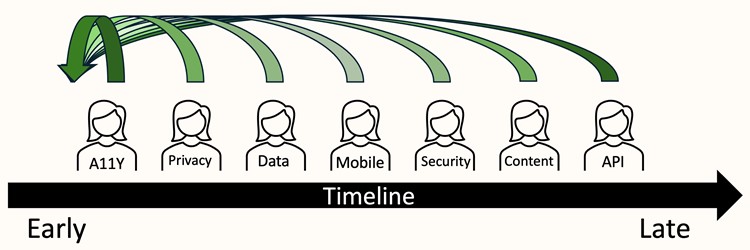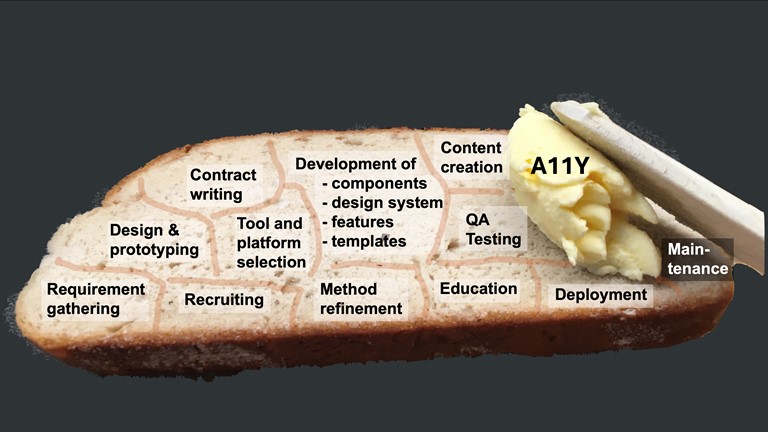Too much accessibility?
Digital accessibility (a11y) is usually very stimulating and meaningful. Sometimes even profitable. But it can also be frustrating and expensive. Especially when it comes as an afterthought: When huge checklists with accessibility requirements must be met after everything else is already in place.
When people tell me of such experiences I think of a large lump of butter on a sandwich. All at once is simply too much. Especially if people are telling you to hurry up.
What about "shift left"?
A common recommendation about accessibility is that you should start early. This is not news of course, but definitely part of the solution.
The principle is sometimes called "shift left": Get things done earlier = shift their position to the left on a timeline. For testing, the advantage is obvious: Adjusting early is usually much easier (and cheaper) than adjusting late.

In fact, there are many "shift left" strategies, each promoting some important quality:
- Accessibility-first
- Privacy by design
- Data driven
- Mobile first
- Security from the start
- Content first
- API first
- ...
What happens if we line up all qualities and then left-shift, one by one, from right to left, putting each one first in line?

We could get a very busy initial phase...

...or, if everybody is politely accepting when other shifts take place, we will get back to where we started!

Don't get me wrong.
I'm not advocating against early action.
I just want to suggest another analogy.
The butter spread method for accessibility
Accessibility work should not only start early, but also be evenly distributed. That's why I propose the analogy with spreading butter over a slice of bread.
I think we get the best results if we include a little accessibility in every "bite". Here are some examples of what this could mean in practice:
- Requirement gathering – What needs do our users have? How can we reach a wider audience? How accessible are existing solutions?
- Design & prototyping – What kind of solution do we want? What should it look like when resizing text? What should it sound like in a screen reader?
- Contract writing – We need to ink accessibility requirements into contracts, because they tend to have an impact for many years.
- Tool and platform selection – These can make accessibility easier – or more difficult. Find out before committing.
- Recruiting – We may need to hire people with new abilities – and maybe disabilities!
- Development – It is easier to build great features if design system, components and templates are already accessible, but we still need to check.
- Method refinement – We probably need to integrate accessibility in procedures and routines.
- Content creation – Writers should use plain language, editors need to describe images, video producers add captions...
- QA testing – Even if we do testing in earlier stages, we probably need another round when things are getting ready. Testing will be less demanding after distributing responsibilities over earlier stages, but not eliminated.
- Education – Co-workers shoult learn a11y basics and the responsibilities that come with their role. And what about onboarding for new employees?
- Deployment – Perhaps we must document accessibility, and instruct support staff about accessibility features?
- Maintenance – Some work items are more effective if postponed. For example, getting user feedback on the finished product is only possible after the product is finished. Also, the organization needs to stay up to date, and perhaps schedule audits.
Not only will this spread accessibility work over time – it will also spread responsibilities between roles, with the advantage that everybody can have a shorter checklist.
Add layers
One good thing about the bread and butter analogy is that you can have more layers than accessibility! We may not be able to deal with all qualities from day one, but we can apply as many thin layers as we need.
Iterate for perfection
The spread will probably be a bit patchy in the beginning. Perhaps you must keep a far-from-perfect tool for some time? This is common. But make sure your organization strives to become more mature over time. You might find our Avocado method for accessibility maturity helpful.

